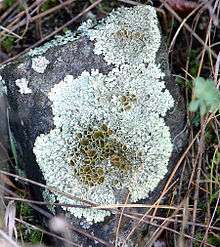Xanthoparmelia
| Xanthoparmelia | |
|---|---|
 | |
| Xanthoparmelia cf. lavicola, a foliose lichen, on basalt | |
| Scientific classification | |
| Kingdom: | Fungi |
| Division: | Ascomycota |
| Class: | Lecanoromycetes |
| Subclass: | Lecanoromycetidae |
| Order: | Lecanorales |
| Family: | Parmeliaceae |
| Genus: | Xanthoparmelia (Vain.) Hale |
Xanthoparmelia (rock-shield lichen) is a genus of foliose lichen in the Parmeliaceae family.[1]:134 Xanthoparmelia is synonymous with Almbornia, Neofuscelia, Chondropsis, Namakwa, Paraparmelia, and Xanthomaculina.[2] This family of lichen is commonly found on the mid-east coast of the United States.
The name means 'golden yellow parmelia'. The photobiont (photosynthetic partner) is trebouxioid (a genus of algae).
Identification
Distinguishing between species involves how much they are attached to the substrate, whether or not isidia are present, lower surface color, and chemical spot tests.[1]:134 All members of the genus react to spot test as K-, KC+ yellow, with medulla reaction varying from species to species.[1]:134
Species
- Xanthoparmelia chlorochroa
- Xanthoparmelia conspersa (Parmelia conspersa)
- Xanthoparmelia cumberlandia
- Xanthoparmelia lavicola - a foliose(leaf-like) lichen found on basalt[3]
- Xanthoparmelia maricopensis
- Xanthoparmelia mexicana
- Xanthoparmelia mougeotii (Parmelia mougeotii)
- Xanthoparmelia nana
- Xanthoparmelia pokomyi
- Xanthoparmelia subramigera
- Xanthoparmelia scabrosa
- Xanthoparmelia tinctina
- "Xanthoparmelia metastrigosa" - a foliose lichen endemic to summit of Mt Canobolas, NSW, Australia[4]
Role in weathering rocks
Minerals in rocks can be weathered by the growth of foliose lichens on exposed rock surfaces. This can be attributed to both physical and chemical processes. Lichen can chemically weather minerals such as calcite by producing organic acids like oxalic acid. This reacts with minerals in the rock, dissolving them and weakening the rock. As a result of this many rocks that have or once had lichen growth exhibit extensive surface corrosion. By-products of this weathering are poorly ordered iron oxides and amorphous alumino-silica gels, the neoformation of crystalline metal oxalates and secondary clay minerals. Lichen physically weather rocks by penetrating the rock's small crevasses with their rhizoids. The expansion and contraction of the roots causes smaller cracks to expand. (Chen, Jie, Hans P. Blume, and Lothar Beyer).
Impact on human habitation
These combined processes - of chemical and physical weathering - also serve to deteriorate asphalt shingles, with foliose lichen byproducts dissolving the limestone (calcium carbonate) used as filler and their rhizoids expanding cracks which develop in the shingles over time.
Gallery
.jpg) Xanthoparmelia plittii
Xanthoparmelia plittii Xanthoparmelia sp.
Xanthoparmelia sp. Xanthoparmelia subramigera growing on an asphalt shingle on a roof in the town of Berwyn Heights, Prince George's County, Maryland, USA
Xanthoparmelia subramigera growing on an asphalt shingle on a roof in the town of Berwyn Heights, Prince George's County, Maryland, USA
References
- 1 2 3 Field Guide to California Lichens, Stephen Sharnoff, Yale University Press, 2014, ISBN 978-0-300-19500-2
- ↑ Lumbsch TH, Huhndorf SM. (December 2007). "Outline of Ascomycota – 2007". Myconet. Chicago, USA: The Field Museum, Department of Botany. 13: 1&ndash, 58. Archived from the original on March 18, 2009.
- ↑ Dobson, Frank S (2005). Lichens An Illustrated Guide to the British and Irish Species. The Richmond Publishing Co.Ltd. pp. 459–460. ISBN 978-0-85546-095-2.
- ↑ "Xanthoparmelia metastrigosa". Retrieved 2015-06-20.
External links
| Wikispecies has information related to Xanthoparmelia |